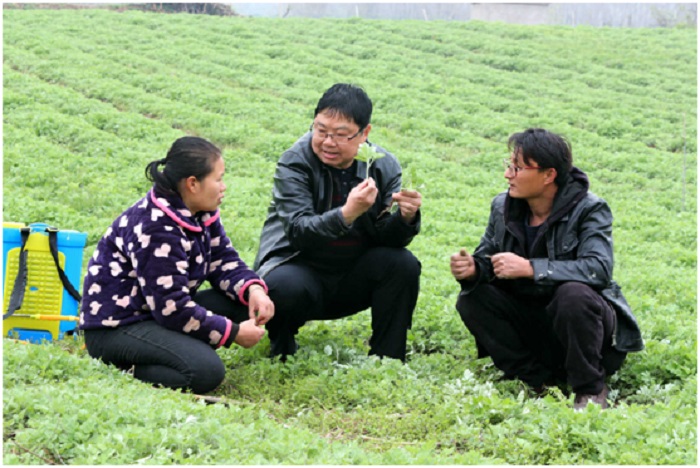



Thanks to the technologies and assistance provided by the local government, Hou Yan, a registered impoverished farmer in northeast China’s Liaoning province, has built a greenhouse and become better-off.
Hou comes from Qingliangshan village. Her family encountered obstacles in 2017 when her husband was confined to bed due to illness, which increased the burden of the schooling of her two children.
To help the villager, Qinglianshan township allocated poverty alleviation funds to set up a vegetable greenhouse for her and invited an expert from the Liaoning Academy of Agricultural Sciences to teach her how to cultivate edible fungi, according to Shi Yu, Party chief of the township.
Zhang Jijun is the expert sent by the academy to the autonomous county. Zhang heads a work team for tech-led poverty alleviation and a team for edible fungi cultivation in the autonomous county. The expert usually drives about two hours to Hou’s greenhouse to teach her cultivation techniques.
“Make sure of enough sunlight and fresh air for the mushrooms to improve the yields and quality,” Zhang told the farmer.
This year, Hou earned about 50,000 yuan ($7,650) from cultivating edible fungi. “Zhang comes to the village two or three times a week to provide guidance and suggestions, and helps me improve my planting skills,” the woman said.
Hou is one of the beneficiaries of China’s poverty alleviation efforts through science and technology, which have been an important part of the country’s strategy of poverty alleviation and development.
China has advanced innovation-driven and targeted poverty alleviation with greater input of science and technology as well as human resources, said Xu Nanping, vice minister of science and technology, at a press conference on Dec. 23.
Xu added that the country has upgraded the mechanisms for the collaboration among different ministries, paired-up assistance between the eastern and western regions, and joint actions among sci-tech management departments at ministerial, provincial, municipal and county levels.
China’ Ministry of Science and Technology (MOST) has pushed forward poverty alleviation in targeted poor areas. Since 2012, it has implemented over 250 science and technology projects with the support of key national research and development programs in five targeted impoverished counties, namely, Jinggangshan and Yongxin in Jiangxi province, Pingshan in Sichuan province, as well as Zhashui and Jiaxian in Shaanxi province.
The MOST has invested 280 million yuan in these counties, helped them attract investments totaling about 860 million yuan, and trained more than 8,600 grassroots cadres and technical personnel.
The ministry has continuously improved the innovation capability and industrial competitiveness of the five targeted poor counties and helped them achieve high-quality poverty elimination.
Meanwhile, the MOST has made concerted efforts with enterprises and other government departments to advance poverty alleviation in contiguous poverty-stricken areas.
The ministry, together with the National Railway Administration and China State Railway Group Co., Ltd., has taken the lead in contributing to regional development and poverty alleviation in the impoverished Qinling-Daba mountain areas.
By accelerating the infrastructure construction in the areas, speeding up the commercialization of scientific and technological achievements, and boosting the cultivation of traditional Chinese medicine plants and the industries of the wood ears and rare edible fungi in the areas, the ministry has continuously enhanced the endogenous growth drivers in the areas.
Since 2012, the ministry has invested nearly 520 million yuan in the areas, assigned 27,500 technical personnel to the areas, and trained 5,211 key rural entrepreneurs in science and technology.
The MOST has also worked hard to advance poverty alleviation by developing industries.
Since 2012, science and technology departments across the country have established 1,290 platforms for innovation and entrepreneurship in poverty-stricken areas and provided pairing-up technological assistance for 77,000 impoverished areas.
They have sent 289,800 scientific experts and input more than 20 billion in impoverished areas, as well as launched 37,600 science and technology projects and introduced more than 50,000 technologies and new crop varieties to poor areas.
The actions of science and technology departments have made important contributions to changing growth drivers, increasing production efficiency, and improving people’s livelihood in poverty-stricken areas.


The Executive and members of the.


The Acting Director, FCT Directorate of.


President Bola Ahmed Tinubu has been.



Barely a month after resignation of.


An Abuja based Legal Practitioner, Osuagwu.



Convener of Equitable Remedy, Mrs. Magaret.


Contractors handling the contract for city.


Nigerian government may have concluded plans.


The Diplomatic Correspondents Association of Nigeria.


A rights group, “Follow Me Talk.
Leave a Comment